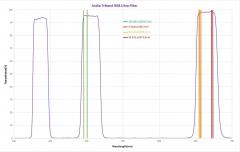(Antlia: AntTriband-II)
(Bruttopreise sind mit 19% bzw. 7% MWSt kalkuliert. Sollte die MWSt in Ihrem Land höher sein, übernimmt LACERTA GmbH die Differenz.)
zzgl. Versand
Durchmesser: 50,8mm
Verwendungszweck: Triband Ultra
Sorte: RGB
Versandgewicht: 1kg (Versandkosten)
Lieferbarkeit
(Der Lagerbestand dient nur zur Information und beinhaltet auch bereits reservierte Exemplare)
Wien: Wir bestellen gerne für Sie!
Linz: nur noch 1 Stk.
Lager: geringe Stückzahl
Öffnungszeiten
Woanders billiger? weiter...
Antlia Triband RGB Ultra II Filter
die Version II des Filters hat eine Durchlasskurve, welche auch die H-Beta Linie umfasst!
Antlia Triband RGB Ultra Filter
It is designed for light pollution suppression for OSC and Mono cameras.
The
spectral design selected the most substantial information in the RGB
bands, which makes Antlia Triband RGB Ultra Filter possible to shoot
over 90% of deep sky objects, in addition to its excellent performance
on emission nebula, different from other ultra-narrowband filters, it is
able to capture galaxies, reflection nebulae, and star clusters from a
Bortle 8 location to Bortle 1 while presenting more balanced RGB colors
in your images. Also, it has a broad bandpass designed to cope with
faster optics up to the f/2 focal ratio.
Quantum Efficiency
The quantum efficiency of the B
channel in current CMOS sensors is often significantly lower than that
of R and G channels. Antlia team was to provide a filter with a more
realistic color balance for astrophotography from light polluted
locations. The problem with the low blue wavelength efficiency becomes
apparent when imaging reflection nebulae and blue stars. In CMOS
sensors, the blue wavelengths also contain contribution from the
stronger green spectrum, thereby affecting the balance of the blue
colours. Many popular imaging objects contain reflection nebula with
faint blue hues such the central part ofNGC2264. Therefore, we designed
Antlia Triband RGB Ultra Filter that not only retains the HSO emission
signal but alsoincreases the amount of Luminous flux of the blue B
channel. By improving the blue wavelength transmission, the color of
thephoto is better balanced and easier to manage in post processing.
Application and Performance:
- It is workable to shoot galaxies, reflection nebulae and star clusters.
- Refined coating process makes the Triband RGB Ultra filters with excellent halo suppression and improvedsignal-to-noise performance.
- It has been specifically designed for balanced color transmission using Antlias experience in spectrum design.
- The balanced transmission allows the minimal color cast to broadband emission objects such as stars, galaxies, andglobular clusters.
- The Triband RGB Ultra can be used with nearly all systems as fast as f/2 with minimal loss of efficiency or shifts inspectral response.
- When shooting LRGB with mono cameras, unless you are wanting to image LDN (dark nebulae) the Triband RGB Ultracan be used as a luminance filter replacement for objects such as nebulae and galaxies to improve contrast and signal tonoise ratio.
- The Triband RGB Ultra is able to better isolate the H-alpha, O3 and blue spectrum from the background light pollution.
- For visual use, Triband RGB Ultra filter ensures the high transmittance of the HSO emission line and can be used for observing deep-sky objects with large-diameter telescopes.
- The filter provides excellent flexibility and compatibility with both OSC and Mono camera systems.
- It facilitates the imaging of most astronomical objects using all optical configurations down to f/2 focal ratio.
INFO!
Code: MGEN-3 | Die Liefersituation ist weiterhin stabil:
Zzt. sind alle benötigte Teile in unserem Zentrallager vorrätig.
Neubestellungen werden nach Zahlungseingang in etwa 2-3 Arbeitstage fertiggestellt.
mehr Infos
INFO!
Code: FN2008c-new | Die Liefersituation hat sich verbessert:
Durschschnittliche Lieferzeit bei Neubestellungen: etwa 120 Tage nach Bestelldatum
Zahlungen erbitten wir zeitnah nach unserer Benachrichtigung über Fertigstellung und Test!
mehr Infos
INFO!
Code: FN25010c-new | Die Liefersituation hat sich verbessert:
Durschschnittliche Lieferzeit bei Neubestellungen: etwa 120 Tage nach Bestelldatum
Zahlungen erbitten wir zeitnah nach unserer Benachrichtigung über Fertigstellung und Test!
mehr Infos
INFO!
DunkelfeldmikroskopeWir konfigurieren Ihr Dunkelfeldmikroskop nach Ihrem Wunsch.
Die Liefersituation hat sich entspannt! Die bis 30. November 2023 abgegebene Bestellungen werden bis Ende Dezember 2023 fertiggestellt und stehen (nach Benachrichtigung) zur Abholung bereit.
mehr Infos
WELCHES TELESKOP SOLL ICH KAUFEN?
Fragen Sie uns - Kontakt
Unser Shop in WIEN
Unser Shop in LINZ
Adresse und Öffnungszeiten
Zahlung und Versand
Vor dem Kauf (Ratgeber)
Rücksendungs-Formular
astronomieforum.at
astronomie.de
mikroskopie-forum.at
bird.at Forum
Links und Partners
Veranstaltungen (Kalendarium)
Firmendaten
Allgemeine Geschäftsbedingungen (AGB)
Haftungsausschluss
Urheberrecht (Copyright)
Widerrufsbelehrung
© 2005-2019 Lacerta GmbH.
All rights reserved.

 Zahlung und Versand
Zahlung und Versand
